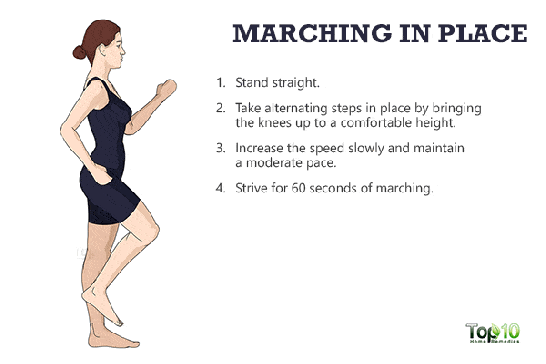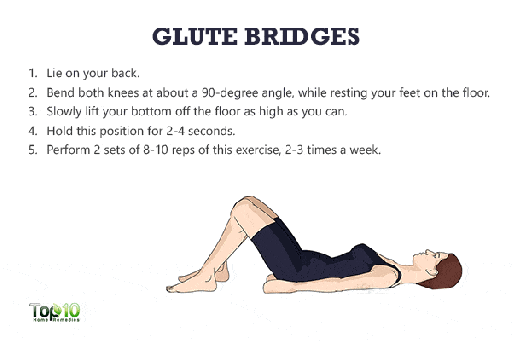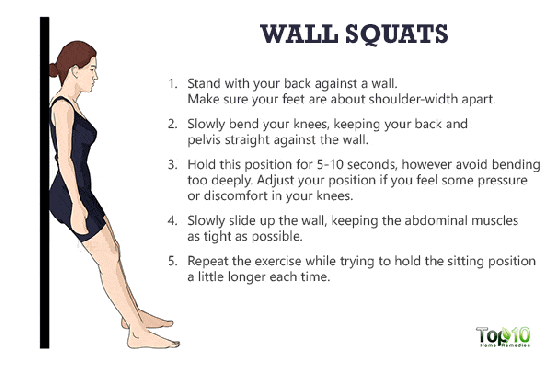10 SIMPLE EXERCISES AND STRETCHES TO KEEP YOUR KNEES STRONG AND HEALTHY
The fact is that women have a greater risk of injury to the anterior cross-ligament of the knee than the male population. Some studies indicate a 10-fold risk to men.
In addition to many risk factors, there is also the angle between the knee and hip, the hormones and the weakness of the muscles of the backbone. Although many of the factors are genetically determined and practically impossible to alter, this is not the case with the silk profile of the posterior backbone.
The problem with the muscle weakness of this region is actually the inadequate balance of forces between the front and back beds. If the quadriceps (front posterior) is overwhelmed with respect to the posterior backbone, the force that is transmitted to the front cross-ligament of the knee may cause unwanted consequences. This is due to the inability of the backbone at any given moment to keep the calf underneath, which is a recipe for an injury of this type.
However, we know that strong knees balance your body and help keep the correct position and therefore the importance of healthy elbows is often not recognized until a problem arises, and most often your knee is injured.
And regardless of age, anyone can experience knee problems at some point in time, for various reasons like playing sports, after a rigorous routine exercise or participation in other activities can cause muscle strains or tears of ligaments that give rise to problems with the knee.
The pain may be strong enough to limit your daily activities, while for some it may only be mild, but in any case, you must not ignore knee problems, because knee problems are not always the result of problems in the actual knee joints.
Because all muscles and joints near the knees are closely related to keeping the knees in a healthy state, it is important to practice the area around your knees.
These ten exercises will help you build a firm and stable knee, although the article is with foreshadowing women because of the greater risk women are exposed to, however, these exercises are welcomed for everyone, practical and easy to perform.
10 simple knee-strength exercises that can be easily practiced at home.
1. Partial Squats
Squats are your best friend when it comes to knee problems and they are one of the best knee rehabilitation exercises that help train your leg muscles and also improves balance and coordination.
What experts suggest is that partial squats are more effective when performed before and in conjunction with exercises of higher intensity than your full progression of the workout, while one study of 2014, published in the Journal of Strength and Conditioning Research, suggests that the partial squats can be helpful for athletes of strength and power athletes during a strength-speed mesocycle while peaking for competition.
Now to do it:
Follow the instructions in the picture below

2. Hamstring Stretch (Standing)
These are an important group of muscles that stabilize the knee that drop from the back of the thighs to the knees, and the muscles work together to curl and bend the knee and extend the hip joint, so this is a good one exercise to strengthen the muscles and support the smooth functioning of the knee. Otherwise, there are more variants of this routine exercise and you can choose one according to your option.
Also, in a 2004 study published in the Journal of Athletic Training, it was found that standing and lying tetchy tendons were comparable efficiently in improving flexibility, measured by increasing the range of knee movement, as in the study published in 2013 in the European Journal of Orthopedic Surgery and Traumatology, it has also been found that standing stretches are better than the seat extends when it comes to hamstring.
How to do it:
Just follow the instructions in the picture below

3. Marching in Place
An easy exercise that suits people from different age groups and knee conditions and does not require specialized equipment and offers home exercise options or you can do it on the beach, a great exercise to help relieve pain in your knees.
Helps to increase the strength of your quads without actually putting any weight through the knee joints and it is also good to improve your balance as well as the health of your heart and weight management.
How to do it:
You need to follow the instructions in the picture below

4. Calf Raises
We know that a very common knee-related injury is torn meniscus, which is part of the spine cartilage on both sides of the knee, which sits between the larger two bones of the lower leg and the bone of the upper leg and is more prone to injuries twisting of the knee or other degenerative changes.
This exercise initiates the help of meniscus by strengthening the muscles that surround and stabilize the knee, helps the muscles of the ankle to improve coordination and balance, thus keeping the knee on the proper plane because they put minimal pressure on the knee and are ideal for recovery from a damaged meniscus.
Now to do it:
Follow the instructions in the picture below

5. Straight Leg Lifts
This exercise helps to improve knee stability, joints by strengthening the muscles from four sides of the thighs and the more powerful your quads, the more control they have on your knees, but we recommend that you get caught with low activity, such as is walking or cycling before you do this exercise.
How to do it:
You need to follow the instructions in the picture below

6. Step Ups
This is a great knee-strengthening exercise that helps to improve knee stability and strengthen quadriceps, as strengthening the accompanying muscles helps to reduce the pressure of the knee joints, which relieves pain, and you can also use aerobic steps or stairs for this exercise.
How to do it:
Just follow the instructions in the picture below

7. Side-Lying Leg Lifts
This exercise is effective for toning the hip, but primarily targets the abductor muscles (the outer side of the thighs) that are important for playing the sport and carrying out your everyday activities, as it works to create tension in your gluteus medius (anterior thigh), which helps them make them stronger and more stable.
How to do it:
Follow the instructions in the picture below

8. Glute Bridges
This exercise is essential for healthy elbows, as it helps control the movement of the knees, preventing them from crashing inward, but they form the basis for strong knees because weak or inactive stupid can cause all knee problems. This exercise also works to strengthen your mice, hamstring, and abs, while minimally does not press on your knees.
How to do it:
You need to follow the instructions in the picture below

9. Wall Squats
This is the best exercise to help you assess the strengths and weaknesses within your knee joints, but the wall squats are the best because less strength passes through the knees when performed, and also this exercise is simply perfect for anyone who suffers from pain in the knees.
The 2016 study, published in the Journal of Physical Therapy Science, reported that the use of the wall also helps control the usual compensation schemes, such as pelvic rotations, dynamic valgus and leg swings in the legs observed in the environment for training and although exercising puts pressure on the knees with repeated bending, it helps to protect the delicate joints and muscles in and around them, however this exercise is a particular boon to runners and athletes or those with knee injuries.
How to do it:
Follow the instructions in the picture below

10. Calf Stretch (Gastrocnemius Stretch)
Because it is important to take care of your calves and to loosen them to avoid pain or knee problems, this exercise is one form of exercise that can keep these muscles loose and relieve pain in the muscles and knees. It is also beneficial for the treatment of plantar fascia, and therefore, in a 2013 study published in the Journal of Sports Rehabilitation, gastrochemical-soleus extensions have been found to be complementary to plant-fascia-specific stretching.
How to do it:
You just need to follow the instructions in the picture below

Source: Team Fitness Training